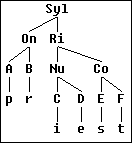Temporal interpretation
The first step in phonetic interpretation of a prosodic structure, is to assign a temporal interpretation to each node in the structure. This is done by specifying rules for:
- durations for constituents which are treated as terminals in the phonetic interpretation
- overlap between adjacent nodes in the prosodic structure
Across syllables, a left-to-right model is used:
- the duration of a constituent is the sum of the durations assigned to the daughter constituents, minus the overlap specified at the boundary
Within syllables, a coproduction model is used:
- the duration of a constituent equals the duration assigned to the prosodic head of that constituent
- weak nodes are overlaid on their strong sister nodes at the left or right edge, depending on whether the configuration is weak-strong or strong-weak, respectively
In the coproduction model the following rules apply:
- if no duration is specified for a weak node, the duration is equal to the amount of overlap between the weak node and its strong sister node
- if no overlap is specified between a weak and a strong node, the amount of overlap equals the duration of the weak node
- a negative amount of overlap specifies the amount of non-overlap between a weak node and its strong sister node
Example
Duration:
Nu => 600.
E => 250.
F => 200.
Overlap:
On + Ri => 200.
A + B => -80.
E + F => 120.
 Analysis
Analysis  Temporal interpretation
Temporal interpretation
Note: these rules are overly simplistic: normally, rules for duration and overlap make use of feature values encoded on a constituent; also, we don't normally use the category labels A, B, C, D, E and F.
Arthur Dirksen / adirksen@prl.philips.nl / January 1995

